By Jan Girand
Thomas Jefferson, assisted by the diplomatic skills of Robert Livingston and James Monroe, successfully negotiated the Louisiana Purchase from French emperor, Napoleon Bonaparte 200 years ago this year. The land stretched west of the Mississippi River to the Rocky Mountains, north to the Canadian border, and south to the Gulf of Mexico. It almost doubled the size of the United States and eventually contained 13 new states and parts of two others.
New Orleans and Louisiana – city and state – were in a year-long state of celebration of their bicentennial when the North American Association of State and Provincial Lotteries (NASPL, said as a word, sounding similar to “Nashville”) held their annual gathering there mid-September 2003.
Representatives of the New Mexico Lottery – in the persons of CEO Tom Shaheen, several Lottery employees, and most of the volunteer board of commissioners and some spouses – attended. The spouses, herein also known as “companions,” paid their own expenses to attend.
The New Mexico Lottery, begun April 1996, now has 63 employees and is governed by an unpaid seven-member authoritative board of volunteers, chosen by the state’s governor. The Legislative Finance Committee has advisory oversight of the Lottery. The projected fiscal 2003 sales is $137 million, all proceeds going to the Lottery Tuition Fund, which directly benefits the state’s students in the form of educational scholarships. (See the Focus page for a NMLA news release about a Roswell woman who just won $25,000.)
A “lottery companion” wrote this essay taking you along on her tour. As a companion, I didn’t have to sit in daylong meetings but was entertained with two days of choice tours of New Orleans and its surrounds.
Looking out the window high above the earth, seeing blue sky and fluffy clouds below gives the eerie feeling of being topsy-turvy. As we began our descent, our vista was huge expanses of sparkling water – the Gulf of Mexico, lakes Borgne, Pontchartrain and Salvador, lagoons, bayous including Bayou Metairie, coastal wetlands, marshes, swamps and the silvery ribbon that is the meandering Mississippi – and brilliant green vegetation of dense marshes, aged forests of live oak, woodlands and crops of sugar cane. It was a beautiful, rare sight for land-locked New Mexicans from a land of prolonged drought.
We stayed at the Fairmont Hotel on Baronne Street, which has its own local history lore and tales of the rich and famous who stayed there. It’s a short walk from there, perhaps six or eight blocks total, first to Canal Street and then down Bourbon Street, the Vieux Carré (French Quarter), for which the street is famous. The French Quarter is also close to the riverfront.
Our companion tour guide, Marcelle, later said the Mississippi River is at its widest near the French Quarter, where it runs 200 feet deep.
From a Louisiana tour guide booklet: “In 1718, Jean Baptiste LeMoyne, Sieur de Bienville, chose a high spot along the Mississippi River to be the center of the French colony of Louisiana. Surrounded by marshes, swamps, a lake and the river, it was known in the early days as ‘the island of New Orleans.’ Though it was strategically located to control traffic on the Mississippi, it was an unlikely spot for a city – but that has never stopped New Orleans from having a good time, then or now. For nearly 300 years (it) has thrived against great odds – and maybe that’s why most everything is celebrated here!”
Lottery meeting attendees found the Convention Center, site of the NASPL trade show and some of the Crewe de NASPL’s events, much too far to walk from the Fairmont; we frequently shuttled between the two. The companions took off from the Convention Center in two buses for our tours.
Our first all-day tour began 9 a.m. Monday, the first morning after our arrival. I was fortunate to get the bus with an excellent tour guide, Marcelle, a French Creole.
Creoles are at least the second generation born in “the colony” of Louisiana, rather than imported there during their lifetime; they can trace their ancestry back to their country of origin. They are proud to be Creole and definite about which type they are: French Creole, Spanish Creole, African or Caribbean Creole. Or they can be a mixture of two or more of those, or have German or other nationalities added. They are not to be confused with Cajuns, descendants of French people who arrived in Louisiana in the late 1700s by way of Acadia and Nova Scotia, Canada, bringing their own unique traditions with them.
Marcelle was a great storyteller and we, her captive and appreciative audience, privately agreed among ourselves that our schools need teachers like her to make learning history interesting and fun. She spoke in a comfortable conversational way during our travels to and from set destinations, and as we drove past ornate mansions on St. Charles, on our walking tour past the elegant historical mansions in the Garden District, and as we walked through the only City of the Dead we visited, Lafayette Cemetery No. 1. No other guide at the places we visited was as interesting. However, our Cajun swamp boat guide, Mr. Torres, entertained us with his own unique charm.
Day One was “Marshes and Mansions” tour. In addition to a swampland boat excursion, we toured Oak Alley Plantation.
During one of our bus rides, Marcelle spoke of their prairies, totally unlike ours of the southwest, and warned their looks are deceiving. Louisiana’s prairies are large wetlands vegetated with saw grass. If you know exactly where to step, in the center of each saw grass clump, “you can walk on water,” she said, but you’ll sink if you miss-step. Frogs and other enchanting creatures inhabit the wetlands, which she called a “nursery for our wonderful sea-foods.” When asked about Louisiana’s poisonous snakes, she said it has a couple rattlers, and the copperhead and the coral snake, which is nocturnal, and – the most dangerous – the water moccasin. Torres later described the wicked water moccasin lying in the water shallows with its mouth open wide waiting for you or another unwary creature to step in.
Marcelle said alligators only kill when they are hungry. “Beware of an alligator with a patch of dirt on his head,” she cautioned with a grin, because he’s just come out of hibernation and he’s hungry. And she said, “Alligators are enchanted by marshmallows.” She warned swamp boat travelers to keep their feet inside the boat, especially if they wore white tennies. Don’t even dangle them over the side; those ‘gators can jump, she said.
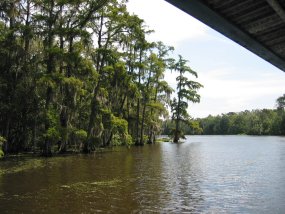
Boat’s Bayou View
By boat, we ventured into beautiful Louisiana swamplands – ours was the swamp of Bayou Boeuf – in an open-sided, top-covered boat, piloted and narrated by Torres, who had 37 years’ experience as an able alligator hunter. He and generations of his family lived their entire lifetimes, including their educational years, in those swamps.
We slowly drifted down the bayou in the nearly silent boat, without much disturbing the tranquil setting. We seldom heard birds calling, or giant snapping turtles or alligators splashing as they entered the water. They caused little disturbance sliding in and out of the swamp waters, and gracefully gliding through it as we watched. The brilliant green vegetative walls surrounding us, with little glimpse of blue sky except directly above, the still and sparkling waters, and lack of almost all sound made the setting seem surreal.
Bayou means creek, but the bayous of Louisiana are far more impressive and formidable than any the word “creek” brings to southwestern minds. Lining both sides of the wide bayou we traversed, and its smaller tributaries, were huge Spanish-moss-draped cypress trees with their many knees (smooth rounded roots) poking up out of the water so the trees can breathe. Some of our lucky boat travelers glimpsed a great blue heron, which has a wingspan of six feet. Torres said the height of the palmetto plants signify how high the water rises because they must keep their heads above it.
Our able swamp boat captain was sure we’d see alligators. “You see no alligators means der’s one big alligator dat ate all them other ‘gators,” he said in his pleasing Creole drawl.
We saw alligators, in fact, several of varying sizes. When our sharp-eyed captain spotted one, its forehead and eyes barely showing above the water, he threw a marshmallow that bobbed like a float close to the boat. Making few ripples, the alligator smoothly progressed to the marshmallow, grinned big and took the tiny confection into his huge gaping mouth. Torres tossed more marshmallows, one at a time, to keep the alligator lured close to our boat to provide travelers, at least those close to the side-rails, several photo-ops per alligator.
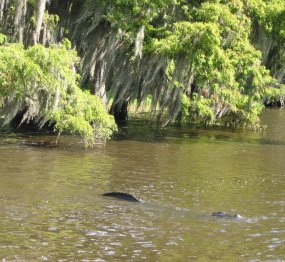
A ‘gator leisurely making his way towards a marshmallow
Marcelle had said, tongue-in-cheek, marshmallows are one solution to their alligator problem. Feed them enough marshmallows, their teeth will rot, then the hunters can just grab those toothless ‘gators by their tails and swing them out of the water onto the banks.
Torres said there are 36 species of snake, not just the four poisonous ones, and the bayous also have poisonous spiders. He described the consequences – swollen neck, ice packs, antihistamines and antibiotics for a week – when one bit him. “What hurt most, it was beginning of my ‘gator-hunting season.” His hunt was seriously delayed, hurting him in his pocketbook.
“When you boat along the bayou at night using your flashlight, you see dark red eyes looking at you, those are male ‘gators; clear red eyes are females. You see clusters of blue eyes staring at you, those are water spiders,” he said.
Spanish moss is gathered for use in upholstery. He said moss picking is more dangerous than alligator hunting. Poisonous snakes and spiders lurk in the moss wrapped around the trees in the swamp.
Another danger, he said, are the aggressive black-headed bumblebees, more dangerous than Africanized killer bees; the black swarms chase after you and bite you.
Alligator hunters hang baited hooks in trees high above the water – too high for other critters to reach and steal the bait – because alligators can leap high. The hunters go out the next day to see if they caught anything.
We passed a small boat with two happy hunters; for us they held up, and danced a jig with, a small white-bellied alligator as we glided by, breaking the stillness only with our shouted attaboys.
Alligators can run and swim 35 to 40 miles an hour. Marcelle said her grandmother taught her that she “cannot outrun an alligator; if one’s after you, zig-zag, but they can catch you on the zag. Best you climb a tree, Marceline, but don’t stop. Climb fast and high, ‘cuz them alligators can jump!”
Torres said if you are eating alligator in a restaurant, taste a very small piece of fat; if it tastes good, they substituted pork thinking you’d not know the difference. “If it tastes bad, it’s alligator.”
Growing up, Marcelle’s grandmother told her, “Sure you can eat alligator, Marceline, but you got clams, shrimp, all them good things to eat. You don’t need to eat alligator.”
Marcelle resides in a small community outside New Orleans, where she can step out her back door and fish the bayou. She described a sight she saw recently. “Nowhere but around here, besides maybe in a Norman Rockwell painting, would you see such a sight,” she said. “A truck passed by with little kids proudly sitting in the back of the truck, up on top of a load of alligators.” Dead ones, of course.
When questioned, she said hunters are now getting around $14 a foot, but got as much as $18 a foot not long ago.
After the boat ride ended, Torres invited us into his large back yard to view some of his caged pets. Pierre and Marie, two huge, grinning alligators stared at us with open mouths. They were so still we thought they were taxidermied until they hissed like angry cats.
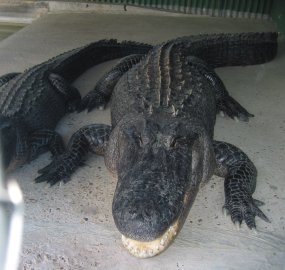
Pierre and Marie
They reminded me of words I learned in junior high from a Walt Disney song from the movie, Peter Pan: “Never smile at a crocodile; no, don’t be taken in by his welcome grin. He’s imagining how well you’d fit within his skin.©” I found myself singing those lines on the bayou, to the amusement of fellow travelers. I’d say – having not seen a crocodile up close and personal (and there are none around New Orleans, Marcelle said) – those ‘gaters’ smiles are ever bit as broad as a crocodile’s, probably more so.
In spacious cages, too, many varieties of brilliantly hued birds, gathered by the Torres family from the bayous, proudly strutted their stuff like a miniature Mardi Gras parade.
Marcelle gave us local history in brief. The Spaniard, Herñando de Soto, came through the area in the 1500s. In 1718, King Louis took New Orleans — and the Mississippi River, all of its tributaries and all land around it — for France. Later France gave Louisiana to Spain because it was mostly useless swampland and had no silver and gold. “The Spanish were here for 40 years, but New Orleans remained a French city and no Spanish was spoken, only French. What can I say? The French are stubborn.” It later became French again. In 1803, Napoleon Bonaparte sold Louisiana to Thomas Jefferson – America’s Louisiana Purchase – for 4-cents an acre.
Marcelle spoke of “the German Coast.” Germans were enticed to settle the forbidding swamplands by being given land and two or three African slaves to work it. She said the Germans were the original settlers of the plantation country. Then, houses were not as imposing because they were of less importance than the land. The definition of a plantation is a large area of land dedicated to one crop. The first crop the Germans grew was indigo, but it killed the harvesters because it coated their lungs. They tried other things. This area was mostly too wet to successfully grow cotton.
In the 1750s, the Jesuits introduced sugar cane, which was the best crop for the area and a true treasure; it became Louisiana’s “white gold.” It likes wet, spreads out and grows like grass. Planted in the fall, the cane is planted sideways and the joints sprout in the spring, making a close, compact vegetation harvested in the fall of the next year. Previously, temperatures and seasons dictated harvest time, when the sugar was up. Now, said Marcelle, they use chemicals to bring up the sugar, to prolong the harvest or fit the harvester’s busy schedule. A columbine cuts the cane, throws it up and back, cuts it into joints, blows off the leaves and loads it into trucks. What used to take “an army” of people harvesting by hand is now done by five or six people with machinery going from place to place, to what Marcelle called “small concerns” of about 400 acres each. An average Louisiana farmer can provide the annual sugar intake – at an average of 65 pounds a year per person – for 60,000 Americans.
Louisiana’s four refineries turn the cane into raw sugar, and again refine it into white sugar.
Our tour’s two busloads traveled along the Mississippi River to the Great River Road in Vacherie to the historic Oak Alley Plantation. Before viewing the inside of the mansion, we were fed lunch under a large open-air sugarhouse shed. Beyond the many acres of manicured grounds and outbuildings, 600 acres of sugar cane fields still surround two sides of the plantation, and 450 acres are virgin woodlands.
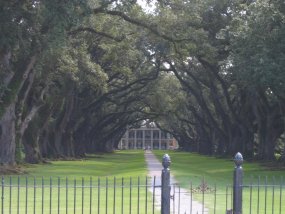
Entrance to Oak Alley
Oak Alley is named and most noted for its quarter-mile “alley,” comprised of 28 live oak trees nearly 300 years old, that forms an evergreen canopy leading to the Greek revival-style antebellum mansion.
A wealthy French Creole sugar planter, Jacques Telesphore Roman, built Oak Alley for his young wife, Selina, who was 18 when they married in 1834. He selected the site to build his mansion because of the avenue of oak trees already planted a hundred years earlier, by a now-unknown settler. He began building with 57 slaves, and it took 2 ½ years to complete in 1839. The veranda that completely circles the house is 18 feet wide, the ornate ceilings are 12 ½ feet high and the thick walls are solid brick. All materials for the “big house” came from the land upon which it sits. It’s furnished throughout with antiques. Most of the furniture is small-sized because then French Creole men averaged 5-foot 4-inches, and their women averaged five feet in height.
Over the dining room table hung an unusual air conditioning system. Consisting of pulleys and a large flat piece resembling a window shade, it was slowly fanned back and forth above the table over a block of ice. Besides the ornate place settings, on the table was a clear glass flask with a long narrow neck. While family and guests dined, the flask was usually draped with a lace doily to hide its less-than-eye-pleasing contents. The flask was their flycatcher; inside was a sugar and oil mixture that lured then trapped flies and other insects inside, where they perished. Food was cooked over open flame in a separate building behind the mansion. The mansion had 93 field slaves and 40 house servants.
In the upstairs guest bedroom we viewed a rolling bed with a Spanish moss mattress. Servants rolled the mattress with a large rolling pin to smooth it before the guest retired each night. The same bed was used – with a block of ice underneath – for the laying in state of the deceased. When someone died in the house, the mirrors were draped with black netting so their souls could depart without being trapped within their reflections.
Jacques died at age 48 and Selina, who didn’t know how to manage it, surrendered the plantation to her son in 1859. Around 1866, he was forced to sell it – the mansion and 1,200 acres – at auction for $32,000.
Only a few of the many fine mansions that once graced the Mississippi River survive.
Marcelle explained that it was not the Civil War that destroyed the plantations. In Europe and elsewhere, only the first-born son inherits the property. Here, heirship was dictated by the Napoleonic Code, by which this French colony was then governed. Property passed equally to all children, and families were often large; as many as 12 or 18 were born to a plantation owner, legitimate and otherwise. During the French Colonial period, the Napoleonic Code dictated that a man’s illegitimate offspring inherited equally with those from his lawful marriage. That caused the once large plantations to be chopped into progressively smaller sections until the land was too small to be self-supporting.
Also along came the great flood that killed the sugar cane, and then the great depression. The banks came into possession of the mansions, which were costly to maintain. There were only a few cases of private wealth that kept mansions in the family, or that could buy and maintain them.
“The South is always wistfully looking back,” Marcelle wistfully remarked.
New Orleans is several feet lower than the river. The highest ground is closest to the Mississippi, sitting on a ridge, where the first plantations were built; the swamplands and crops were behind them. The plantation owners were caretakers of the land; it was their responsibility to assure the land was not flooded.
New Orleans, already water-logged, sits in a bowl that would fill with water if not for the 17 huge pumping stations constantly working to keep the city above water. In addition to the shallow water table, the area averages 60 inches of rain a year.
At one time, New Orleans was the richest port in the U.S. It was an international port, and everything there was French. Marriages were arranged, often in France. The entire lives of many owners and their wives were spent on the plantation. He was responsible for everything outside, and she was responsible for everything inside, said Marcelle.
Because of the undependable ways of the river – which, as Marcelle explained, often changed its mind on which way to wander and how much water to flow – residents built their homes on stilts, without basements, and they often did not occupy the first floor, living on the second floor and above.
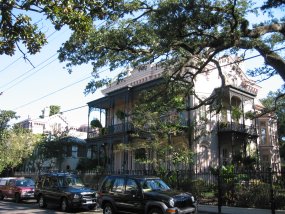
Homes in the Garden District
On Day 2, the companions took the Garden Tour. It began with a leisurely Marcelle-narrated walking jaunt of New Orleans’ Garden District. Long ago, a break in the Mississippi River dumped fertile river mud upon its outer banks. With that especially nourishing soil, the mansion owners cultivated fine grounds and gardens, for which this exclusive residential area was named.
Many of the houses were built during Louisiana’s antebellum “golden era” of sugar and cotton.
We strolled the oak-shaded streets past Greek Revival, Italianate and Queen Anne homes. Marcelle pointed out that these giant oaks – unlike those along the bayou and on plantations beyond city traffic – are not draped with Spanish moss because moss only thrives in pure, unpolluted air. As we passed these historic homes – most of them heavily adorned with black wrought-iron “lace” – Marcelle regaled us with anecdotes and history of their earlier and current occupants.
Marcelle said the Elm Mansion in the Garden District was one of the very few early homes of New Orleans built with a basement. During World War II, a German spy lived there and used the basement as a radio room from where he sent secret coded messages. After he was finally caught, he was suspected of causing many of the sinkings of American ships in the Gulf that were loaded with wartime supplies and headed to the war zones. The spy returned to Germany where he presumably lived happily ever after.
As we passed the historic house that is now the home of Ann Rice – the prolific author of horror genre – Marcelle said all of Ann’s autos are stretch limos. In a city with many such ostentatious conveyances, Ann’s are recognized by their unique license plates, each bearing the name of a witch. (Who says writing doesn’t pay?)
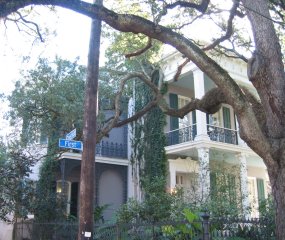
Home of Ann Rice
Some of the ornate homes had been built for as little as $10,000 because of slave labor, she said. The lives of slaves during the French and Spanish occupation in the New Orleans and Louisiana area were not as bleak as those in other places and under other regimes, including the American Occupation. During the French Colonial period, residents believed slaves had souls. Slaves were raised as Catholics, laws said they could not be injured or separated from their families, and many were educated in Europe. Some of the house slaves were cultured and even attended the opera. Whereas intermarriage between whites and blacks was not allowed, it was a common and accepted practice for wealthy men to have separate, secondary homes and families with black mistresses. The high head-gear – the bright colored cloth turban – signified such a woman, who was held in much higher regard than ordinary female slaves. The home the master bought for her was legally hers, and under the Napoleonic Code, the children he had with her inherited his estate equally along with his legitimate children.
Marcelle said conditions for slaves changed, considerably worsened, with the American Occupation.
We drove down St. Charles Avenue, the most prestigious address in New Orleans, and passed historic universities: the famed medical school Tulane; and Loyola, whose Jesuits introduced sugar cane to the area revitalizing Louisiana. She spoke of the parochial school, Sacred Heart, famed Notre Dame, and Xavier University – a college specifically for blacks. And she mentioned theirs is the longest continually used trolley line in the USA. She said, because of the humid heat, mules instead of horses pull the wagons in the summer.
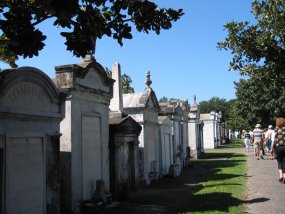
One of New Orleans’ Cities of the Dead, and the oldest: Lafayette No. 1
Our next walking tour was through a City of the Dead. Because of the shallow water table, all New Orleans’ cemeteries are aboveground tombs. We visited Lafayette Number 1, with 18th, 19th and early 20th century tombs. Marcelle called these two-story mausoleums–with single sealed slabs or doors engraved with the names of its occupants–“Eternal family condos.”
The function of these is interesting. The top floor can only hold one casket, containing the most recent dead, on a shelf. When another member subsequently dies, the remains of that one are removed from the wooden casket, the casket is discarded, and the body-in-a-bag is shoved off the far end of the shelf to make room for the newest occupant. The remains drop down to the bottom floor, where it joins that of its ancestors. It is an early method of conserving and recycling space.
“It’s so convenient. Unlike other places, here you only need to go to one spot to visit your entire family, generations of them,” said Marcelle with a smile.
She said the inside of the tombs is very hot and humid, which is especially good for speeding up decomposition when there is little time between deaths. “Grandma might die just a few months after Grandpa,” she pointed out.
“I personally know they are hot and humid in there,” she added. “I spent many hours of my childhood playing inside them.”
She said it had been a childhood ritual: Her grandmother regularly sent her and her brother to the cemetery to pull weeds and whitewash the family tomb. And her grandmother claimed kinship to those in the other neighboring tombs and instructed the children to also whitewash and clean up around those. When Marcelle was grown, she realized she “wasn’t related to the neighbors. Don’t you know? My grandmother was practicing urban renewal, renovating her block in preparation of her own death.”
Marcelle pointed out larger tombs with specialized carvings – such as a fire-wagon – and with many sealed doors instead of one. She said those were society tombs, where bodies of people – who did not already have a family tomb and who belonged to certain groups or vocations such as firemen or priests – could be placed at far lesser expense. “Eternal apartment complexes,” she called them.

A “society tomb” or “eternal apartment complex,” this one for firemen
Some of the newer tombs in other cemeteries, built within the last few years, cost as much as $1/4 million.
After viewing Lafayette Number 1, our busses took us to New Orleans’ City Park, the third largest U.S. municipal park, with 250 live oaks listed on the national registry.
“You will see trees 600 years old and though they are way past middle-age, they are still producing little acorns without Viagra®!” quipped Marcelle.
The locals revere their live oak trees, so-called because they are considered evergreen, remaining green nearly year-around. They are some of the largest in crown spread, and oldest, living trees in North America. Some live oak trees have been known to live 1,000 years.
The historic live oaks in City Park are liberally adorned with Spanish moss and resurrection fern; both plants absorb their nutrients from the air and not from their host trees. The fern got its name from its ability to go almost instantly from a dead appearance during a drought to fresh and green following rain (or a sprinkling from a modern watering system).
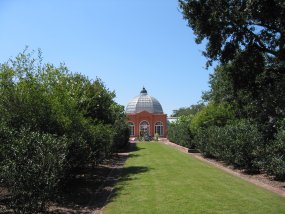
A Small Part of the Huge New Orleans Botanical Garden
Also in the City Park is the New Orleans Botanical Garden. As part of their bicentennial celebration, the exhibit features plants of the Louisiana Purchase – typical of those grown in Jefferson’s gardens at Monticello, and in the gardens of Napoleon’s and Josephine’s home, Chateau de Malmaison, during the late Colonial and early American periods.
The group ate outside the Longue Vue House and then toured the magnificent home on an eight-acre estate that includes an ornate garden. The Greek revival mansion was built as the home of a New Orleans cotton broker, Edgar Bloom Stern, and his wife, Edith Rosenwald Stern, heiress to the Sears and Roebuck fortune. The house was completed in 1942, and Roosevelts and Kennedys stayed in their guesthouse.
Before an established movie actor arrived as a guest at Longue Vue House, he sent a letter to the Sterns requesting that their guests not pester him for autographs. The Sterns were honestly mystified; who among their aristocratic and wealthy guests (socially far above him) would want his autograph?
Although New Orleans is three feet below sea level, this house was built on a ridge six feet above, and it has a basement used by Stern as a dark room for developing his photography. Along with the house’s history, the narrator also related some information about the Sears and Roebuck enterprise. Edith’s parents were Julius and Augusta Rosenwald; Julius became sole owner of the highly successful catalog business. At the beginning of the 1929 Wall Street Crash, Julius guaranteed the stock market accounts of all Sears employees, assuming a $7-million debt. His generosity was credited as a stabilizing influence for the country at a very difficult time in its history.
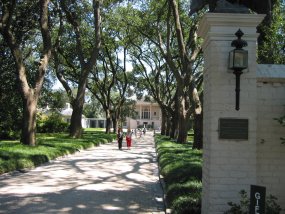
Longue Vue
During one of her monologues, Marcelle spoke of the many assets brought to Louisiana by Africans. As well as the jazz they inspired, she credited them for food crops, especially the rice they brought with them, their art and their fine craftsmanship.
Water hyacinths had been introduced into Louisiana to add dense vegetation to the river banks to keep them from washing away, to keep the Gulf of Mexico from encroaching upon the land. That upset the natural ecosystem, and the plants began to choke out the other vegetation. Then a fellow introduced nutria, hyacinth eaters, to fix that problem. That again upset the ecosystem. The nutria – described by Marcelle as giant, mean and aggressive 15-pound rats with orange fangs – rapidly reproduced and took over, eating far more than hyacinths. She said they look similar to otters except for their rat-like tails. They have become a serious problem, eating through the levee systems. Many solutions have been considered, including enticing Cajuns to trap them by putting a big price on their pelts. Although their fur is luxurious, they are little valued. “Why’d anyone want them? What woman wants a fur coat made from giant rats?” Marcelle quipped.
One gimmick was to put a price on a nutria tail. But then, what was to stop the ingenious Creoles from cutting the tail into several? Then, too, how are you going to dispose of all those tails? You can’t bury them; those clever Creoles would just dig them up and resell them. This was one of Marcelle’s many humorous, entertaining notions. We never tired of listening to her.
She said New Orleans has100 masquerade balls and 80 parades a year; they use any excuse to have one. She described one parade comprised only of oysters on the half-shell chased down Bourbon Street by a bottle of Tabasco and a wedge of lemon.
One evening, some of the Crewe de NASPL and their companions, including those from New Mexico, had their own official Bourbon Street parade. The delegates were outfitted with quantities of beaded necklaces, feather boas and masks and outlandish hats, then gathered behind a float or two, stilt-walkers, a few costumed folks including Popeye and a sexy Betty Boop. An energetic Salvation brass band led the way as they wiggled, waggled and strutted their stuff down Bourbon Street.
Send an Email to editor@roswellwebmag.com , giving your Email address and your mailing address, and we will mail this (below) collector postcard to you from Roswell, New Mexico.
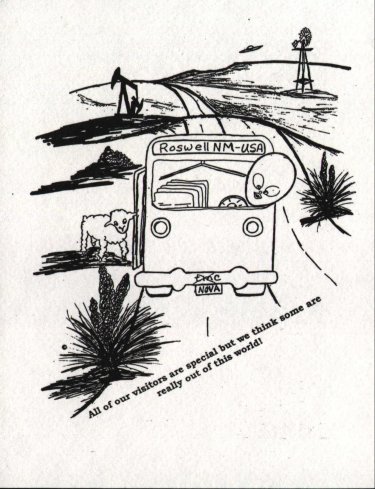
“All of our visitors are special, but we think some are really out of this world!”
Rwm
 Roswell Web Magazine
Roswell Web Magazine